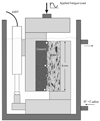Shear fatigue micromechanics of the cement-bone interface: An in vitro study using digital image correlation techniques
- PMID: 18846550
- PMCID: PMC2790035
- DOI: 10.1002/jor.20777
Shear fatigue micromechanics of the cement-bone interface: An in vitro study using digital image correlation techniques
Abstract
Loss of fixation at the cement-bone interface is known to contribute to aseptic loosening, but little is known about the mechanical damage response of this interface. An in vitro study using cement-bone specimens subjected to shear fatigue loading was performed, and the progression of stiffness changes and creep damage at the interface was measured using digital image correlation techniques. Stiffness changes and creep damage were localized to the contact interface between cement and bone. Interface creep damage followed a three-phase response with an initial rapid increase in creep, followed by a steady-state increase, concluding in a final rapid increase in creep. The initial creep phase was accompanied by an increase in interface stiffness, suggesting an initial locking-in effect at the interface. Interface stiffness decreased as creep damage progressed. Power law models were reasonably successful in describing the creep and stiffness damage response and were a function of loading magnitude, number of loading cycles, and contact area at the interface. More microcrack damage occurred to the cement when compared to the bone, and the damage was localized along the interface. These findings indicate that damage to the cement-bone interface could be minimized by improving cement-bone contact and by strengthening the fatigue resistance of the cement.
(c) 2008 Orthopaedic Research Society.
Figures






Similar articles
-
Fatigue creep damage at the cement-bone interface: an experimental and a micro-mechanical finite element study.J Biomech. 2009 Nov 13;42(15):2513-9. doi: 10.1016/j.jbiomech.2009.07.014. Epub 2009 Aug 13. J Biomech. 2009. PMID: 19682690 Free PMC article.
-
A fatigue damage model for the cement-bone interface.J Biomech. 2004 Oct;37(10):1505-12. doi: 10.1016/j.jbiomech.2004.01.011. J Biomech. 2004. PMID: 15336925
-
Creep dominates tensile fatigue damage of the cement-bone interface.J Orthop Res. 2004 May;22(3):633-40. doi: 10.1016/j.orthres.2003.09.007. J Orthop Res. 2004. PMID: 15099645
-
The effect of cement creep and cement fatigue damage on the micromechanics of the cement-bone interface.J Biomech. 2010 Nov 16;43(15):3028-34. doi: 10.1016/j.jbiomech.2010.06.031. Epub 2010 Aug 7. J Biomech. 2010. PMID: 20692663 Free PMC article.
-
The preparation of bone cement.Br J Perioper Nurs. 2001 Feb;11(2):58-62. doi: 10.1177/175045890101100203. Br J Perioper Nurs. 2001. PMID: 11892336 Review.
Cited by
-
Fatigue creep damage at the cement-bone interface: an experimental and a micro-mechanical finite element study.J Biomech. 2009 Nov 13;42(15):2513-9. doi: 10.1016/j.jbiomech.2009.07.014. Epub 2009 Aug 13. J Biomech. 2009. PMID: 19682690 Free PMC article.
-
The behavior of the micro-mechanical cement-bone interface affects the cement failure in total hip replacement.J Biomech. 2011 Jan 11;44(2):228-34. doi: 10.1016/j.jbiomech.2010.10.020. Epub 2010 Oct 30. J Biomech. 2011. PMID: 21036358 Free PMC article.
-
Bone quality, and the combination and penetration of cement-bone interface: A comparative micro-CT study of osteoarthritis and rheumatoid arthritis.Medicine (Baltimore). 2018 Aug;97(35):e11987. doi: 10.1097/MD.0000000000011987. Medicine (Baltimore). 2018. PMID: 30170401 Free PMC article. Review.
-
FATIGUE OF BIOMATERIALS: HARD TISSUES.Int J Fatigue. 2010 Sep 1;32(9):1400-1412. doi: 10.1016/j.ijfatigue.2009.08.007. Int J Fatigue. 2010. PMID: 20563239 Free PMC article.
-
The mechanical effects of different levels of cement penetration at the cement-bone interface.J Biomech. 2010 Apr 19;43(6):1167-75. doi: 10.1016/j.jbiomech.2009.11.033. J Biomech. 2010. PMID: 20022010 Free PMC article.
References
-
- Aspenberg P, Goodman S, Toksvig-Larsen S, Ryd L, Albrektsson T. Intermittent micromotion inhibits bone ingrowth. Titanium implants in rabbits. Acta Orthop Scand. 1992;63:141–145. - PubMed
-
- Aspenberg P, Van der Vis H. Migration, particles, and fluid pressure. A discussion of causes of prosthetic loosening. Clin Orthop Relat Res. 1998:75–80. - PubMed
-
- Bean DJ, Convery FR, Woo SL-Y, Lieber RL. Regional variations in shear strength of the bone-polymethylmethacrylate interface. J Arthroplasty. 1987;2:293–298. - PubMed
-
- Boresi AP, Schmidt RJ, Sidebottom OM. Advanced Mechanics of Materials. New York: Wiley; 1993.
-
- Boss JH, Shajrawi I, Dekel S, Mendes DG. The bone-cement interface: histological observations on the interface of cemented arthroplasties within the immediate and late phases. J Biomater Sci Polym Ed. 1993;5:221–230. - PubMed
Publication types
MeSH terms
Substances
Grants and funding
LinkOut - more resources
Full Text Sources

